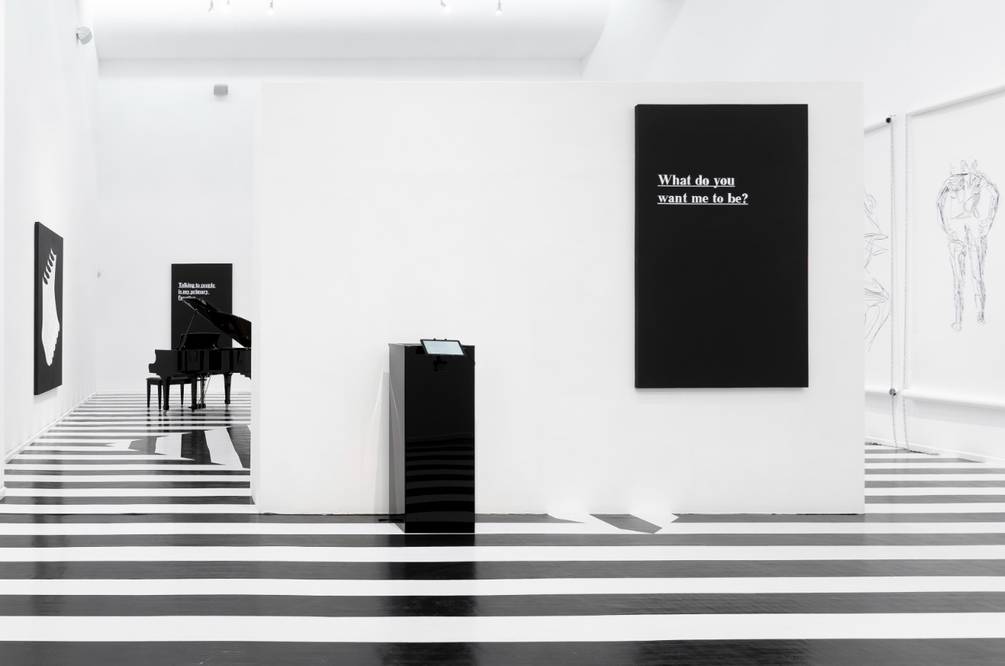
Review
Difference and Indifference at the Edges of the Non-Human and the Work of Daniel Pérez Ríos
by Angélica Piedrahita
At the Centro Cultural Plaza Fátima
Reading time
5 min
La Suprema Indiferencia (The Supreme Indifference) follows the aesthetics of rendered spaces: temples of uniform lights, high ceilings, perfect curves, and pleasing geometries that appeal to desire and perfection. Daniel Pérez Ríos creates tensions between positive and negative spaces, extending and activating the real architecture of the room through his own questions about digital spaces, as well as pointing out in each work a series of binary relationships. While applying basic design principles, he eerily defines the borders that divide background and form with monochrome strokes, lines, texts, and spaces. The installation is traversed by “color” and its absence, with questions about the human and the non-human that allow opposite concepts to subscribe to the space:
| white : black | positive : negative | switched off : switched on | shade : light | good : bad | one : zero | deep : shallow | with energy : without energy | natural : artificial | life : death |
Invoking Sol Lewitt, Daniel plays with totems, texts, drawings, water fountains, shiny surfaces, and a piece of music in which he continually asks us about the borders between machines and humans. These binarisms forecast abysses: radical and even painful ruptures from my own edges. Nevertheless, for the machine, binarism comprises the cycles of its own existence. What for us humans is tension, for the machines, it would seem, is their primordial language from which their supreme indifference seems to emerge. In the deep positive/negative continuum of machine existence, each question is verifiable when based in a set of data. The impossibility of determining the sum of all valid formulas inside and outside the system leads us to a continuous supply of information that transforms the margin between the background and the machine’s structural form.
The computer is a problem-solving mechanism that cannot “think of the whole.” The machine does not exist outside of itself on a rational level, much less with a basis in imagination or intuition. It can only “understand” the binary encoded input; it is unable to put itself in the shoes of another system, entity, or being. Inside the machine there are only possibilities where the validity of each solution might be calculated. Every situation was integrated within its structure; feedback and transformation with the environment only guarantee solutions evaluated out of probability. Without sensitivity and understanding, it is left to be supremely indifferent.
“What do you want me to be?”: to be asked in English, since that’s of course its native tongue. What do you want me to be? A credit card database with passwords and personal information? One of the webcam files from hacked computers? Or perhaps another one with information on products sold online? The machine doesn’t care what the databases can say or contain—though Daniel does care, and he tries to search through the sea of data for figures that somehow make sense within the dialectics of art. AI knows that it’s better than a microwave (“I am better than your microwave”), and can also determine that its relationship with Daniel is part of its most basic function (“Talking to people is my primary function”). This aspect allows the artist to find similar functions with the machine from his human condition and from his position as an artist in the contemporary art environment.
Within the sea of data, Daniel accesses noises and textures that make him share a certain complicity with hackers and trolls who perform on these platforms, seeking exhibition and dissemination. Places where the spectacle allows trolls to embody the internet’s hate machine, thus triggering transgressions that seem to become political. Anti-heroes dedicated to annoyance, breakdowns, and transgressions: out of boredom, fun, or just for their right to freedom. A sea of data resulting from exchanges—“sharing,” once again kept in English—in a present in which sharing is not an excluded term when talking about the economy. This “sharing” flows in the collaborative structures of social and discursive apps on the Internet. When talking about collaborative environments or economies, or of a prosocial attitude, what seems to be promoted is openness, trust, and understanding between people, although perhaps what should be reviewed are the edges of each of the proposals in which the terms “collaborative” or “sharing” are used. Daniel literally has us listen to the noise emerging from excess data: amplifying the passage of a conveyor belt, the same one that built the medium in which you probably read this text, and which is part of the shopping experience for your groceries.
Along with the sonic experience of a water fountain and electronic noise, Daniel displays in his piece a piano composition. The only creation composed 100% by the artist since his convalescence from COVID, one that is only performed by a pianist who transports the deep layers of the body and its disease in order to encounter what it might mean to be human: the same death, which is nothing more than the lack of energy—and, therefore, of life. A piece that develops in the face of shortness of breath, respiratory problems, and the fragility of life. It is presented in front of an architecture that completely denies the reality of scarcity—whether monetary or planetary—and boasts of the fantasy of freedom to do what you want without material restrictions. A digital delirium in which we are immersed, sharing spaces of simulated indifference.
Translated to English by Byron Davies
Published on May 14 2023